Tips and Tricks: How to adjust tabletop RPG mechanics (including D&D) for kids!
Jump to:
- Use a pre-made adjustment
- Simplifying rolls (or general randomization)
- Reduce the character sheet
- Handling spells, attacks, and items
- Tracking health and points
- Overall
Use a pre-made tabletop RPG adjustment
Before starting to homebrew adjustments to your tabletop game, there are people who have already done it and published their work for you! You can try out some pre-made adjustments for a lot of popular games that are designed specifically for introducing kids to the rules in a more gradual way.
There are definitely others out there for D&D 5e and more, but here are two great examples of kid-friendly tabletop RPG adjustments that I’m familiar with and have personal confidence in (because I have played and reviewed both!) to check out:
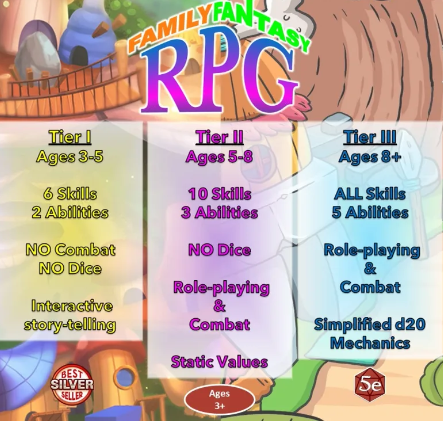
The Family Fantasy RPG series – this tabletop RPG has a tiered system that allows you to introduce basic D&D 5e concepts to kids as young as 3yo in tier 1 and then increase the complexity in tier 2 and tier 3 as their capabilities grow so they get used to 5e rules gradually.
DnD Adventure Club – this is D&D 5e but explained in a very short and comprehensive manner so kids can understand quickly. The mechanics tweak here isn’t as much to the rules but more to the explanation and rewriting a few things to make them easier for new players to work with (i.e. simplifying the way a spell is written).
Simplifying rolls (or general randomization) in your tabletop RPGs
With a lot of games, you can explain the written instructions verbally and your child can absorb that even if they can’t read the rules. However, if your child’s counting and math skills don’t line up with the game’s mechanics, that’s a bit harder to just explain since you’d also need to pre-practice all the math involved.
When my kid was (and kind of still is) developing his counting skills, I tried out a lot of different tabletop RPG modifications to make it a bit more pre-K friendly and help him still be able to play while maintaining the spirit of the game and mechanics.
Simplify your game’s dice to match your kid
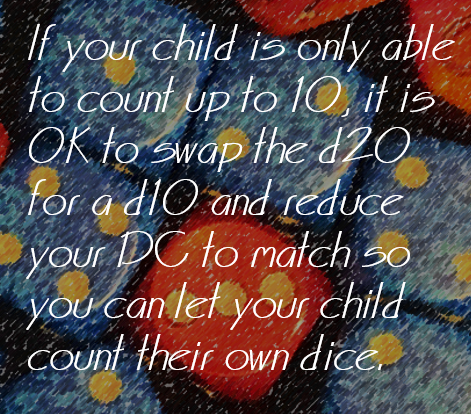
If your child is only able to count to 10, it is OK to swap the d20 for a d10 and reduce your DC to match so you can let your child count their own dice. This is a really easy mechanics modification for your kid to bring your expectations to their level.
I’ve also modified games by substituting a d4 and treating it as 1 = fail, 2 = pass but some complication, 3 = pass, 4 = pass and a bonus.
Both of these methods still keep with the theme of having randomization, and you can still have your child roll this way while the rest of the group sticks with the d20 and your regular DC, if you want. It does increase the odds of getting a crit, but as long as you are OK with that, this game modification can really help alleviate stress on your kid.
Use something besides dice in your tabletop RPGs
I wrote an article a while back about dice alternatives in tabletop RPGs that had a dual purpose – first to keep dice out of the hands of kids who put things in their mouths, and, second, to give some options for kids who can’t count yet.
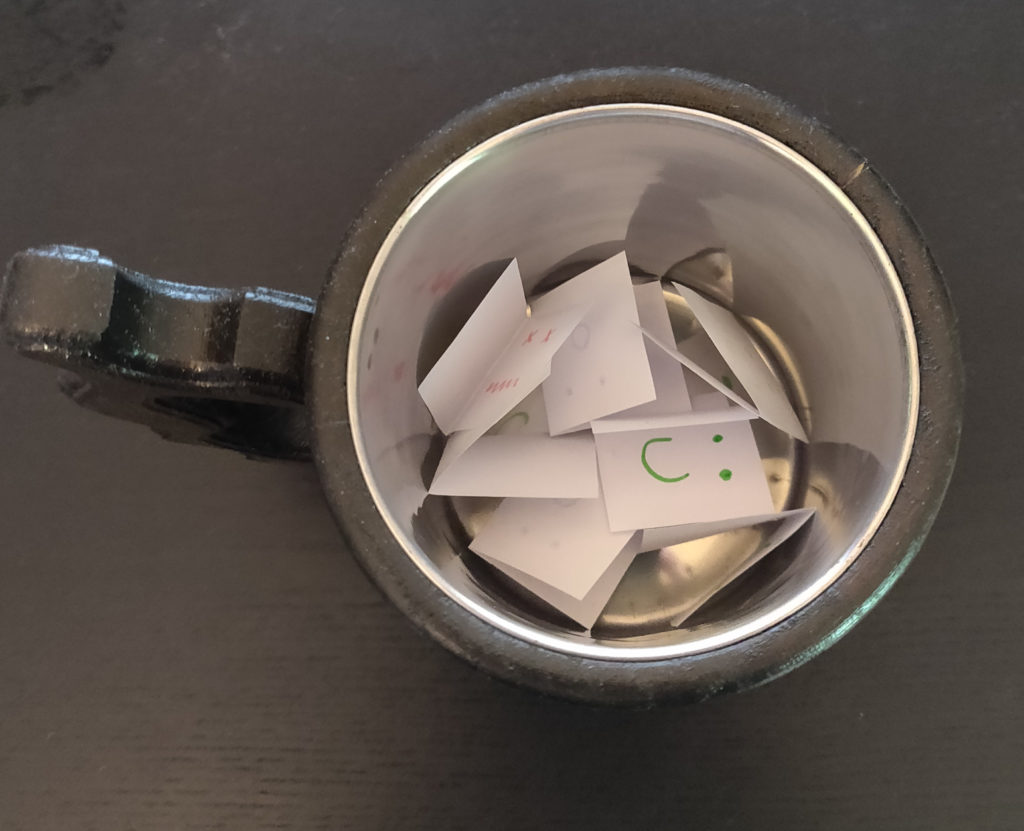
There are several different game alteration methods to check out, but one that I really like using is the pass/fail tokens in a cup. If you want to keep all your probability ratios the same, you can put 20 pieces of paper with smiley or frowny faces on them (instead of numbers) in a cup for whatever ratio you want for your passes and fails and then have your kid pull one to determine their outcome. Your kid can interpret immediately if it is a pass fail without numbers being a roadblock.
Have stats vs. DC with no dice rolls to make math easier
If rolling dice and counting it up each time is getting frustrating for your child, you can also just fix their stats to a set number. If they have a +3 STR, you can add 10 every time (and maybe a bonus for good RP) without rolling to see if it beats the DC you set. This does take the randomization out of your tabletop RPG, but it could also be a good way to simplify for the first few games so you can introduce dice later once your child understands the other basic ideas of the game like RP and item tracking.
Follow the story only to get your kid used to the game
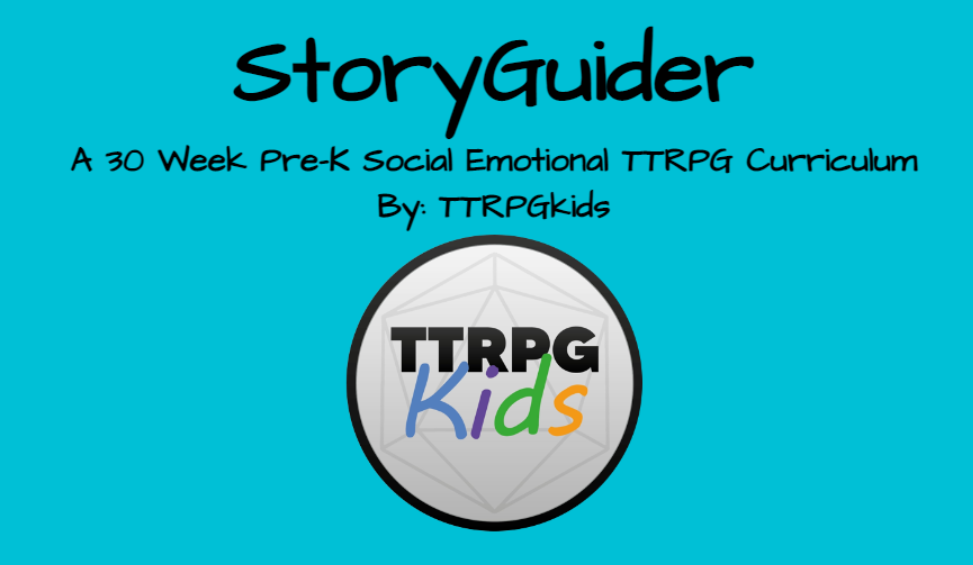
Another possible tabletop RPG modification you can make for your kids is to ditch the numbers all together and just tell a story. On its own, this is maybe borderline a tabletop RPG (this is the category I would put my StoryGuider games into) depending on how you choose to define a game. However, this can work really well if your child needs to build initial confidence in RP and decision-making before you introduce any mechanics OR if they are getting overwhelmed at a table with older kids or grown-ups and need a breather from the math for a bit.
Reduce your tabletop RPG character sheets
The first time I saw a D&D character sheet, I got a little overwhelmed before I actually started to fill it out. The first few sessions, I also had a hard time finding where everything was at a moment’s notice. I was ~25 at the time… and an avid reader who handled engineering data for a living. So, I have to imagine character sheets could be intimidating to kids as well, especially if they are not a strong reader.
With my child, if we ever play a tabletop RPG where he is obviously not understanding or using the character sheets, I will make some modifications (a couple are below) and plan on eventually introducing full rules with some re-written character sheets later:
Draw pictures for stats and skills on your kid’s character sheet
My kid can count and recognize numbers, but he can’t read yet, so the stat boxes on a typical tabletop RPG character sheet don’t really mean much to him… unless I put a picture next to them. For strength, maybe I draw a flexing arm, and, for dexterity, maybe I draw a running stick figure. All you need is something simple to give meaning to what the number represent to your kid.
Here are some stat cards that I made as a mechanics modification for my kid when we played Dino Ninja:
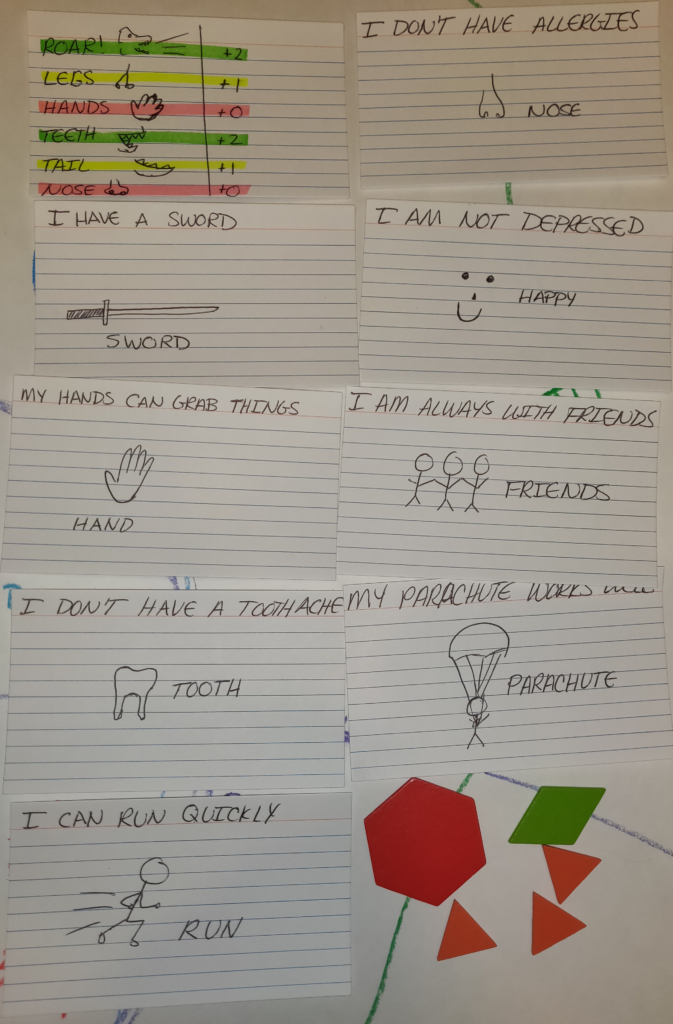
Move blocks of text to a separate page
Some tabletop RPG character sheets include a section for writing backstory details and information about special abilities. This is perfect for readers who do better with one page in front of them, but for players who tend to get overwhelmed by clutter on their sheet, you can leave those boxes blank and fill them out on a separate sheet to help organize it. There were a few character sheets that my kid handled way better once the blocks of text were moved to a reference sheet instead.
Try alternative tabletop RPG character sheets
There are also a ton of alternative character sheets for popular games, like D&D and Pathfinder, that have been redesigned for players with dyslexia that incorporate some of the above elements plus color coding, an easier to distinguish font, and more. A quick google search shows lots of options that are definitely worth checking out for any of your players (or yourself), and I personally have found that this free dyslexia-friendly character sheet works really well for my family.
Handling spells, attacks, and items in tabletop RPGs
There can be a lot to track in tabletop RPGs after a while, especially if you pick a spell-caster (which my kid always wants because, well…. magic). With my 3yo, there’s no way I would expect him to remember a full spell list and what all of his items do, so I help him out. I either help him track everything and remind him of what he has OR I’ll give him some aides:
Use notecards with pictures as a tabletop RPG supplement
Similar to using pre-made spell cards, I will draw a picture on a 3×5 card to represent the spell, item, or attack and then let my kid hold onto it. When my kid wants to use that item or action in the game, he just holds the card up and asks if he can do it. With this game modification, my kid remembers what that item or action does because of the picture, and he has everything laid out in front of him as a good reminder for his inventory. This is also great for kids who are still building a vocabulary and practicing associating pictures and words (think like learning flashcards).
Here are a few cards that I’ve made for modifying tabletop RPGs for my kid- the pictures don’t have to be fancy or super well drawn, so no worries if you aren’t an artist. I just needs to be something that will vaguely remind you child of the action, item, spell, etc.
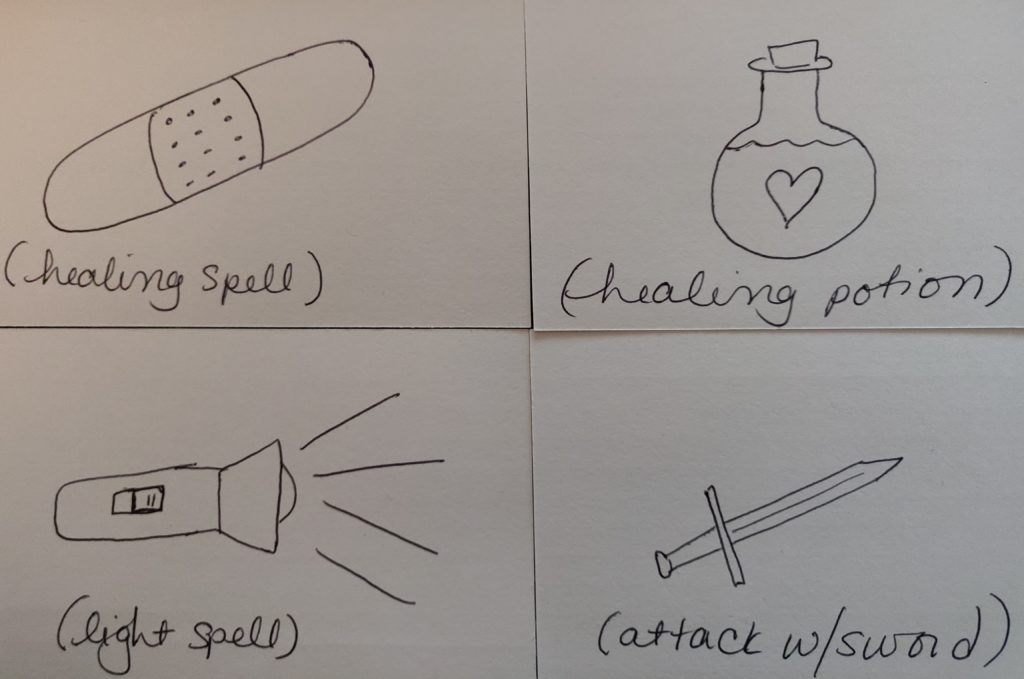
Simplify descriptions for your game’s spells
If you look at the spell book for a lot of tabletop RPGs, there’s a lot of rules about each spell. The text covers the components required, maybe some flavor about how it looks, the casting distance, the area of effect, etc. One of the biggest ways I’ve helped my kid with spell mechanics is by simplifying the description (i.e. saying the light spell just makes a light about as strong as a flashlight) so my kid understands the basics. You could also track all the details for them (i.e. if they cast a light spell, you tell them how far it extends on the map instead of trying to have them remember it all), but this can put a bit of a load on the game master, especially if there are multiple kids playing.
Use a reduced list of spells and items
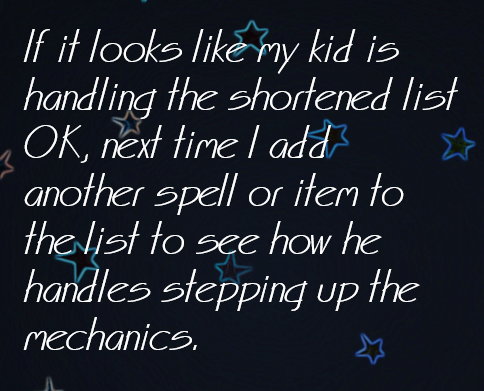
Some games will give a lot of freedom with getting a ton of spells and loot, and I personally love this versatility for regular games with my friends. However, it is a little too much for my kid to track on his own, so I’ll make sure to give him a shorter list of spells and items (maybe 3-4 spells and 2-3 items) to keep track of. If it looks like my kid is handling the shortened list OK, next time I add another spell or item to the list to see how he handles stepping up the mechanics. This tabletop RPG modification lets my kid have autonomy and choice with regards to his spells and items without me needing to remind him of everything. My child doesn’t get overwhelmed, and it also gives me less to track too.
Tracking health and points in tabletop RPGs with kids
Some games have massive health or XP pools, which is great for hitting fine increments of damage and leveling, but if you kid can’t count past 14, they are going to have a hard time understanding how to take 25 damage from a 130 point health pool. For my kid, I simplified mechanics in a few ways so he first could understand number tracking, then I started introducing counting that was at his level. This tabletop RPG modification gave a more gradual progression and actually built understanding versus just getting him to use a mechanic based on just what I told him or having me track it for him.
Use a tracker or checkbox to represent your kid’s game points
My very first tips and tricks article was actually about DIY tabletop RPG trackers for kids, and this worked really well for building initial comprehension of tracking points when my kid was really young (2 years old). Without using numbers, he could add/take away pieces until there weren’t any more, and then…. something happened. Kids get used to the idea and are more excited about learning to count in the next part because they now know that it leads to… something happening.

Adjust your mechanic’s order of magnitude
Another modification that I made after we got past the initial tracking concept was adjusting the order of magnitude for the game’s mechanics. Instead of tracking 70 health… you can track 7 health and reduce the damage amount by the same order. You don’t get fine tuned health tracking, but it is close enough to stay true to the spirit of the game while also letting your child participate and learn at their level. Once they learn to count higher and do more math, you can always increase the order of magnitude as they are ready.
Treat game quantities as fixed amounts
My kid would get overwhelmed with the following tabletop RPG mechanics:
- “roll to see if you succeed with this die”
- “OK, now roll to see how much damage you do with these dice”
- “And you get a bonus die for the modifier”
- “OK, we add those and then we add our skill modifier”
- “and your total is… 5 points of damage, so I’ll subtract that from the health“
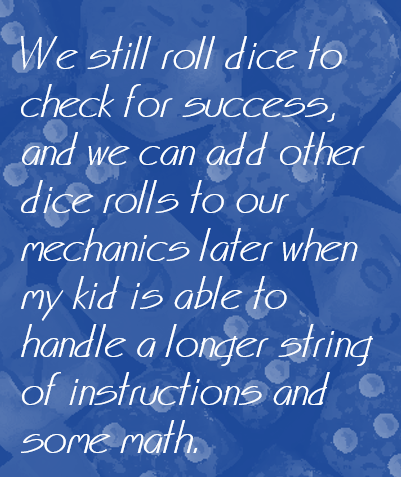
So instead, I’ve modified mechanics for my kid to be:
- “roll to see if you succeed”
- “Great! You deal 5 points! That’s half the health!”
I fixed the amount of health, points, etc to an average amount (similar to the averages given in D&D books) so it was just a little easier for my kid to follow. We still roll dice to check for success, and we can add other dice rolls to our mechanics later when my kid is able to handle a longer string of instructions and some math.
Overall thoughts on modifying tabletop RPG mechanics for kids
Lots of kids are ready to start tabletop RPGs with the full, core rules set… but not all of them are. For young kids or kids who are still building math or reading skills, the mechanics can sometimes create more barriers than structure. We primarily want our kids to enjoy the game and want to come back for more, so making small tweaks to the game rules here and there can really help them find that connection and love the game.
I hope this article gave you some ideas to try out and can help with introducing your favorite games to your kids when you want to give it a try (versus having to wait until they’re older).
And please!! If you have other suggestions or if you use any of these ideas, let me know in the comments! Sharing your knowledge helps other parents, teachers, caregivers, etc to see that other people are bringing these games to their kids and can help them gain some confidence to try it out.
Also make sure to subscribe to the TTRPGkids monthly newsletter to stay up to date on the latest reviews, tips and tricks, game and podcast list updates, and more! Thank you for playing tabletop RPGs with your kids and sharing this awesome hobby with the next generation!


8 thoughts on “Tips and Tricks: How to adjust tabletop RPG mechanics (including D&D) for kids!”